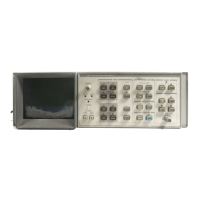A1A2 XYZ Driver Amplifier (85662-60232), Circuit Description
(Serial Number Prefixes: 3004A and Above)
Y Deflection Amplifier ©, ©, (p)
The Y deflection amplifier consists of a single ended to differential voltage to current amplifier
@ which drives two current to voltage output stages. The result is a differential voltage
output to drive the positive and negative Y deflection plates of the CRT. The output has an
average (common mode) voltage of approximately 55 V (equal to the first accelerator voltage
of the CRT).
The voltage to current Y Preamplifier © consists of a differential pair Q113 and Q114 with a
constant current emitter bias supplied by Q115. R127 is used to adjust the collector bias to
position the beam in the center of the CRT when the input voltage is 1 V. This adjustment
also makes up for gun misalignment in the CRT.
Qlll and Q112 are voltage gain stages and Q109 and QUO are voltage to current converters
that drive a virtual ground input to the two current to voltage output stages with equal
but opposite signals. The gain of the Q109 and QUO stage is determined by the emitter
resistance. The differential gain is adjusted by R120 and R119 and the common mode current
is set by R118 and R120.
The current to voltage stages, ® and ®, are identical so only Y+ Current to Voltage
Amplifier © is described. The Y+ amplifier consists of an active load (constant current
source) made up of
Q101,
R101, R102 and R104 and a pull down transistor Q102. R102
and R104 set the base voltage of
Q101
to a nominal dc level.
B.101,
in the emitter of
Q101,
sets the current in the collector. Q102 is biased on by R102 and R104 and is held in linear
operation by the emitter of Q104. R106 is the gain setting feedback resistor that maintains
closed loop operation. R108 biases the current to voltage amplifier input to set the minimum
output voltage to about 5.7 V with no collector current from Q109.
V„
AR106 \
out
\R108 J
15 v
In general, the output voltage of the current to voltage stage is determined by the current
drawn from the input by Q109. This current is supplied by the feedback resistor R106. R106
is a 23.7 k resistor so the output voltage will rise 23.7 V for each milliamp of current drawn
from the input node.
Q103 is a feed forward circuit to help speed up transient response. A rise or fall in input
signal voltage will pass through the emitter follower formed by Q103 and R105 and then are
ac coupled through C102 and C103 to the base of Q102. C102 also couples this voltage to the
base of
Q101.
With the emitter bypassed against rapid voltage changes by C101, the active
load current is also modulated to help the ac response of the output stage.
CR102, CR103, R140 and spark gap E101 are an output protection network to protect the
amplifier from arcs inside the CRT or in the cabling to the CRT.
A1A2 3

